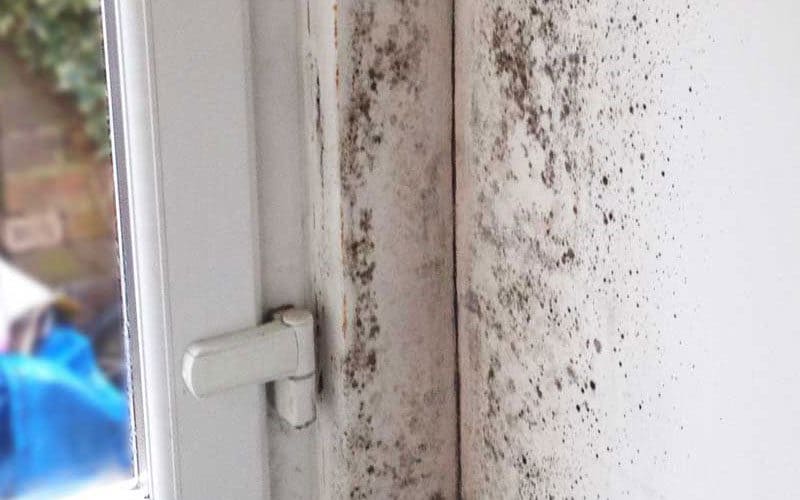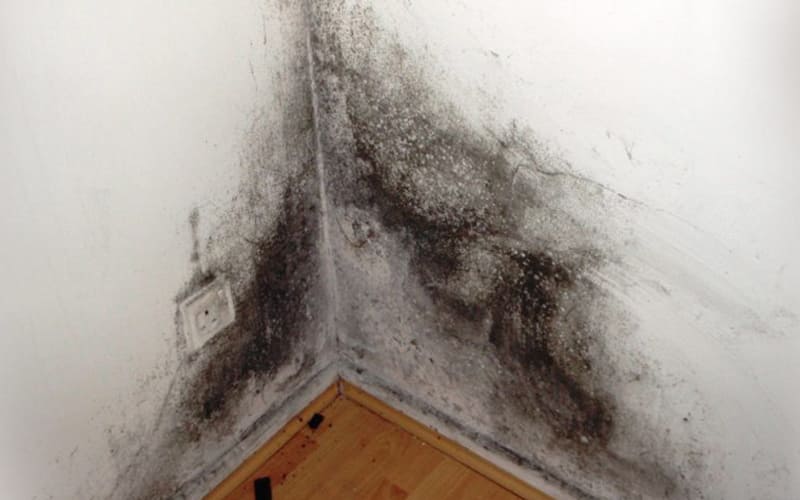Rising damp solutions
SmartDry has been the specialist in solving damp problems in homes for many years. Do you have a problem with rising damp in your property? Have it checked and solved by SmartDry. We cover all of the UK. Request a free damp survey by clicking the button on the bottom of this page or contact us by phone at 0330 8080 636.
SmartDry has been the specialist
in damp solutions since 2013
100% damp-free warranty.
We can solve your problem!
Sustainable solution: better
for your health and home
What is rising damp and where does it occur?
Rising damp is a common problem that can occur in the home. The problem mainly occurs in older homes. Many houses built before 1980 do not have a damp proof course in the ground, or the damp proof course is in poor condition. With a poor or non existing damp proof course, the water found in the soil is absorbed directly by the wall and the damp travels upward, hence the name ‘rising damp’.
The bricks absorb the damp through their pores, causing the damp to migrate upwards into the walls. Through the brickwork the damp rises further into the wall and that is why the walls become damp. This process affects the walls and, in most cases, causes damage to the house itself. It also causes health problems and can create a musty smell in the house. It is important to tackle this damp problem as soon as possible, and it’s best to call an expert in the field of damp control to see how extensive the damp problem is.
The causes of rising damp in the wall
There are various causes for rising damp in the wall. The most common cause of rising damp is the lack of a damp proof course. Usually this is the case in somewhat older houses. Because the damp proof course is missing, the water in the ground is absorbed by the walls of your house. The damp absorbed by the walls often contains harmful salts that remain on the wall after the soil damp has evaporated, which can damage the wall. The majority of homes do have a some sort of damp proof course which consists of damp-resistant material and prevents the damp from the ground to slowly pull upwards through the walls. The damp proof course prevents the foundation and walls from absorbing groundwater. The seriousness of the damp problems at home depends on the state of the groundwater and the thickness of the materials that make up the wall.


The effects of rising damp in the home
Excessive damp is unhealthy for the living environment in the house: it causes high humidity, can feel clammy in the house and it becomes more difficult to heat a house. Mostly, when there is damp, people decide to turn up the heating as it is difficult for the house to get warm, but this leads to a higher energy bill, which everyone would like to avoid. But the most annoying consequence of rising damp is that, in combination with heat, it causes moulds and bacteria to grow faster. When there is rising damp, there is often visible mould or black damp spots on the underside of the walls in the house. This can be very harmful to your health. Therefore, try to solve this damp problem at its source and not just combat its symptoms or effects.
Another problem is that rising damp is only noticeable when damage has occurred to the house. It is therefore very important to take action as soon as possible if you notice one of the symptoms of rising damp. Some signs of rising damp include the paint on the wall starting to chip off, the wallpaper of the wall becoming loose, or damp spots at the bottom of the wall rising up to no more than 1 meter. Below is a short list of the more common signs of rising damp.
You can recognise rising damp by these signals
- Damp spots are visible and mould develops on the bottom of ground floor wall;
- The wallpaper loosens on the underside of the inner wall;
- The floor is damp and the laminate begins to bulge or warp;
- There’s a musty smell in the room of the house;
- There’s a significant increase in condensation in the house;
- The humidity in the house is too high.
3 methods to combat rising damp in the home
There are various methods to treat rising damp. But there are three methods that are most commonly used: injecting the walls, waterproofing the wall or placing wall elements. Every method to solve this damp problem has its advantages and disadvantages. Each treatment is described below and the pros and cons are mentioned.
Method 1: Inject the walls of the house
This solution is most likely the most used method to stop rising damp. It is a relatively quick, simple and inexpensive way to tackle the damp problem. Holes are drilled into the wall just above the floor, these holes are then filled with a damp-repellent liquid or gel. The liquid will expand in the brickwork and eventually stops the damp from spreading into the house. Perhaps this method is the most attractive in terms of price. It can be carried out entirely locally and this can solve the damp problem in the wall in the short term. However, with a simple search on the Internet you will find that the rising damp problem is not effectively and permanently resolved with this method. Chemical injections usually only last for a short period of time, and before you know it, you will be needing to inject the walls again, or try to find a different solution, as the damp will eventually come back. Another adverse effect can be that the wall is sealed by the damp-repellent gel- as a result, the humidity created by daily activities can no longer escape outside. This in turn results in a large increase in the amount of condensation. In our opinion, injecting the walls is not the most ideal solution.
Method 2: Waterproof the walls
Another method to deal with rising damp is to create a damp proof course at the bottom of the walls. This method can be very effective and offers a long term solution against rising damp from the ground. The downside is that this method is a very labour-intensive job that takes a lot of time and also involves high costs. It can become a large renovation project that takes several weeks and has to be carried out by several people. In addition, this method can result in a lot of damage and a lot of dust. What exactly happens if you have the walls redone? Horizontal slots are milled into the masonry at the bottom of the walls, which causes the bottom of the wall to come loose from the top. After the wall is lifted, a water barrier (water-retaining layer) is applied and it ensures that rising damp can no longer occur. Other damp problems, such as penetrating damp or condensation, are unfortunately not solved. Another important aspect that comes into play when creating a damp barrier is that the walls must be easily accessible from the outside. So this solution is quite expensive, time consuming and does not solve ‘all’ damp problems that can occur in the wall.
Method 3: SmartDry DryBricks- The SmartDry System
In our opinion, this is the best solution against rising damp in the wall. Compared to the other two methods, installing DryBricks is inexpensive and takes little time. In fact, in most cases the DryBricks are installed in the outside wall within one day. One of our skilled engineers will install the DryBricks in the wall and clean up at the end of the day. You don’t even have to be at home, as our damp specialists can install the DryBricks themselves without necessarily having to enter your home. This solution is not only suitable for resolving the rising damp but is also an excellent solution for penetrating damp and condensation damp. Installing DryBricks is therefore a permanent solution against rising damp in the house. Another distinguishing advantage over other damp control methods is that the house is not sealed up. The house can continue to breathe and the damp inside the house can be removed naturally. Does this method also have disadvantages? The only possible disadvantage is that the DryBricks are visible from the outside of the house, but the DryBricks are available in six different colours, so the Drybricks can be matched to the colour of the house.
What does it cost to treat rising damp?
When we talk about the costs of treating rising damp, we mainly look at the best solution: Installing the DryBricks. If you have a house with a single brick wall, the costs are £96.00,- (excl. VAT) per linear meter. If you have a house with a rendered wall, engineering bricks or cavity walls £118.00,- (excl. VAT) per linear meter. Finally if you have a natural stone wall £128.00,- (excl. VAT) per linear meter. Would you like to calculate for yourself what the fight against rising damp will cost for your house? Take a look at our ‘Pricing‘ page. This method of damp control is very effective and, of course, permanent. It is a one-off investment which means that the damp in your home will not return. Suppose you only want to combat the symptoms of rising damp with another method, that is possible, but then you have to fight the symptoms periodically and each time brings new costs. In the long run, it’s much easier to choose a permanent and environmentally friendly solution- the DryBricks from SmartDry.
How can you fight rising damp yourself?
It sounds very attractive to tackle this problem yourself. With a bit of dexterity, you quickly think you can tackle this problem yourself as an expert. Here at SmartDry we strongly advise you not to do this. Solving rising damp in the home seems like an easy job, but the consequences can be bigger than you think. If something goes wrong with, for example, injecting the walls, it becomes more expensive to repair this damage. In addition, the damp problem in the house is not yet solved. So have your damp problem dealt with by a specialist in damp control, and save a lot of time and money.
The DryBrick – The solution for rising damp
As mentioned earlier on this page, having the DryBricks installed is the best solution to treat rising damp in the house. It is an innovative and patented solution to combat damp problems. In addition, this solution naturally extracts damp from the wall. Thanks to the simple physics, the damp is removed for good and the indoor climate of the house is improved. Each attached DryBrick can remove 266 cubic centimetres of water per 24 hours, without the help of external energy. This makes the DryBrick method the most durable and efficient treatment against damp problems in the home. Because DryBrick’s are a permanent solution, it’s also the most cost-effective. If you have damp walls the DryBricks will dry them out and after that the walls will always stay dry. SmartDry’s DryBricks are so durable that you never have to replace them.
Allow SmartDry to combat rising damp
Do you want to know if there is rising damp in the walls of your house? Then book a free damp survey. We will be happy to help you solve the damp problem in your home. We have been specialising in combating rising damp for many years now. We solve damp problems in and around the house and have made thousands of homes damp-free. Feel free to contact us by phone and have one of our damp control specialists check your home for damp problems.
Plan a free damp assessment
Feel free to contact us for a free damp assessment or advice from our moisture expert.


